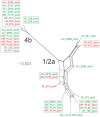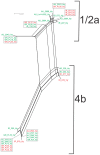Virulence Gene Sequencing Highlights Similarities and Differences in Sequences in Listeria monocytogenes Serotype 1/2a and 4b Strains of Clinical and Food Origin From 3 Different Geographic Locations
- PMID: 29922249
- PMCID: PMC5996115
- DOI: 10.3389/fmicb.2018.01103
Virulence Gene Sequencing Highlights Similarities and Differences in Sequences in Listeria monocytogenes Serotype 1/2a and 4b Strains of Clinical and Food Origin From 3 Different Geographic Locations
Abstract
The prfA-virulence gene cluster (pVGC) is the main pathogenicity island in Listeria monocytogenes, comprising the prfA, plcA, hly, mpl, actA, and plcB genes. In this study, the pVGC of 36 L. monocytogenes isolates with respect to different serotypes (1/2a or 4b), geographical origin (Australia, Greece or Ireland) and isolation source (food-associated or clinical) was characterized. The most conserved genes were prfA and hly, with the lowest nucleotide diversity (π) among all genes (P < 0.05), and the lowest number of alleles, substitutions and non-synonymous substitutions for prfA. Conversely, the most diverse gene was actA, which presented the highest number of alleles (n = 20) and showed the highest nucleotide diversity. Grouping by serotype had a significantly lower π value (P < 0.0001) compared to isolation source or geographical origin, suggesting a distinct and well-defined unit compared to other groupings. Among all tested genes, only hly and mpl were those with lower nucleotide diversity in 1/2a serotype than 4b serotype, reflecting a high within-1/2a serotype divergence compared to 4b serotype. Geographical divergence was noted with respect to the hly gene, where serotype 4b Irish strains were distinct from Greek and Australian strains. Australian strains showed less diversity in plcB and mpl relative to Irish or Greek strains. Notable differences regarding sequence mutations were identified between food-associated and clinical isolates in prfA, actA, and plcB sequences. Overall, these results indicate that virulence genes follow different evolutionary pathways, which are affected by a strain's origin and serotype and may influence virulence and/or epidemiological dominance of certain subgroups.
Keywords: Listeria monocytogenes; actA; diversity; gene sequencing; hly; prfA; virulence.
Figures








Similar articles
-
Genetic Analysis of the Listeria Pathogenicity Island 1 of Listeria monocytogenes 1/2a and 4b Isolates.Curr Microbiol. 2018 Jul;75(7):857-865. doi: 10.1007/s00284-018-1458-4. Epub 2018 Feb 21. Curr Microbiol. 2018. PMID: 29468304
-
Identification and characterization of nucleotide sequence differences in three virulence-associated genes of listeria monocytogenes strains representing clinically important serotypes.Curr Microbiol. 1998 May;36(5):309-18. doi: 10.1007/s002849900315. Curr Microbiol. 1998. PMID: 9541569
-
Virulence Gene Profiling and Molecular Typing of Clinical Isolates of Listeria monocytogenes from Wenzhou, Eastern China.Infect Drug Resist. 2025 Aug 8;18:3957-3966. doi: 10.2147/IDR.S526926. eCollection 2025. Infect Drug Resist. 2025. PMID: 40799954 Free PMC article.
-
Genome organization and the evolution of the virulence gene locus in Listeria species.Int J Med Microbiol. 2000 May;290(2):167-74. doi: 10.1016/S1438-4221(00)80086-7. Int J Med Microbiol. 2000. PMID: 11045921 Review.
-
Listeria monocytogenes lineages: Genomics, evolution, ecology, and phenotypic characteristics.Int J Med Microbiol. 2011 Feb;301(2):79-96. doi: 10.1016/j.ijmm.2010.05.002. Epub 2010 Aug 13. Int J Med Microbiol. 2011. PMID: 20708964 Review.
Cited by
-
Survival strategies of Listeria monocytogenes to environmental hostile stress: biofilm formation and stress responses.Food Sci Biotechnol. 2023 Sep 14;32(12):1631-1651. doi: 10.1007/s10068-023-01427-6. eCollection 2023 Oct. Food Sci Biotechnol. 2023. PMID: 37780599 Free PMC article. Review.
-
Characterization of antibiogram fingerprints in Listeria monocytogenes recovered from irrigation water and agricultural soil samples.PLoS One. 2020 Feb 10;15(2):e0228956. doi: 10.1371/journal.pone.0228956. eCollection 2020. PLoS One. 2020. PMID: 32040533 Free PMC article.
-
Prevalence, Serotypes, Antimicrobial Resistance and Biofilm-Forming Ability of Listeria monocytogenes Isolated from Bulk-Tank Bovine Milk in Northern Greece.Pathogens. 2023 Jun 17;12(6):837. doi: 10.3390/pathogens12060837. Pathogens. 2023. PMID: 37375527 Free PMC article.
-
Liposomal Nanotraps Neutralize Listeria monocytogenes Toxins to Enhance Macrophage Viability and Antibacterial Capacity.Infect Microbes Dis. 2025 Apr 17:im9.0000000000000177. doi: 10.1097/IM9.0000000000000177. Online ahead of print. Infect Microbes Dis. 2025. PMID: 40496477 Free PMC article.
-
Prevalence and contamination patterns of Listeria monocytogenes in Pleurotus eryngii (king oyster mushroom) production plants.Front Microbiol. 2023 Jan 27;14:1064575. doi: 10.3389/fmicb.2023.1064575. eCollection 2023. Front Microbiol. 2023. PMID: 36778843 Free PMC article.
References
-
- Brosch R., Catimel B., Milon G., Buchrieser C., Vindel E., Rocourt J. (1993). Virulence heterogeneity of Listeria monocytogenes strains from various sources (food, human, animal) in immunocompetent mice and its association with typing characteristics. J. Food Prot. 56, 296–301. 10.4315/0362-028X-56.4.297 - DOI - PubMed
-
- Bueno V. F., Banerjee P., Banada P. P., José De Mesquita A., Lemes-Marques E. G., Bhunia A. K. (2010). Characterization of Listeria monocytogenes isolates of food and human origins from Brazil using molecular typing procedures and in vitro cell culture assays. Int. J. Environ. Health Res. 20, 43–59. 10.1080/09603120903281283 - DOI - PubMed
-
- Chakraborty T., Ebel F., Wehland J., Dufrenne J., Notermans S. (1994). Naturally occurring virulence-attenuated isolates of Listeria monocytogenes capable of inducing long term protection against infection by virulent strains of homologous and heterologous serotypes. FEMS Immunol. Med. Microbiol. 10, 1–9. 10.1111/j.1574-695X.1994.tb00004.x - DOI - PubMed
LinkOut - more resources
Full Text Sources
Other Literature Sources
Research Materials
Miscellaneous

